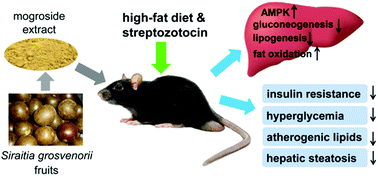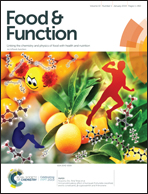AMPK activation is involved in hypoglycemic and hypolipidemic activities of mogroside-rich extract from Siraitia grosvenorii (Swingle) fruits on high-fat diet/streptozotocin-induced diabetic mice†
Abstract
Previous studies suggested the anti-diabetic effect of mogrosides in type 1 diabetes. To evaluate the potential effect of mogrosides in type 2 diabetes, we herein investigated the hypoglycemic and hypolipidemic effects and the underlying mechanism of mogroside-rich extract (MGE) using a high-fat diet in combination with streptozotocin (STZ)-induced diabetic model. MGE feeding for 5 weeks did not result in any obvious impact on the body weight and energy intake, but caused a moderate decrease of organ index in diabetic mice. MGE-supplemented diabetic mice showed a notable reduction of fasting blood glucose (FBG), glycated serum protein (GSP), serum insulin, homeostasis model assessment-insulin resistance (HOMA-IR), and serum atherogenic lipid profiles in a dose-dependent manner, whereas significant increases in the anti-atherogenic lipid profile, insulin sensitivity, glucose and insulin tolerance capacity with high dose (300 mg kg−1) MGE were observed (P < 0.01). Besides, hepatocyte polymorphism, lipid accumulation and steatosis were ameliorated and restored to near normal at the high dose. Furthermore, hepatic 5′AMP-activated protein kinase (AMPK) signaling was dose-dependently activated. Accordingly, the mRNA levels of hepatic gluconeogenic and lipogenic genes were downregulated and fat oxidation-associated genes were upregulated. These findings suggest that the hypoglycemic and hypolipidemic activities of MGE are probably attributed to the attenuation of insulin resistance and activation of hepatic AMPK signaling.



 Please wait while we load your content...
Please wait while we load your content...